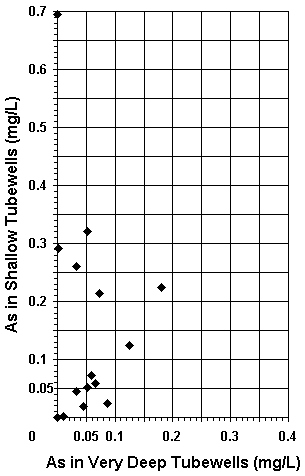 |
The success rate of providing safer water by drilling deeper tubewells was estimated using Figure 16. These results suggest that drilling deeper tubewells is only moderately promising because the drinking water it yields often has arsenic concentrations greater than the 0.05 mg/L national standard. For example, 10 of the "shallow" tubewells have more than 0.05 mg/L arsenic, while only 3 of their adjacent "very deep" tubewells successfully accessed drinking water with less than 0.05 mg/L arsenic.
This 30% success rate may increase if even deeper tubewells are installed. For example, the 5 deepest (229 to 335 m or 751 to 1,100 feet below ground surface, bgs) tubewells have an average of 0.033 mg/L arsenic, while their adjacent "shallow" (< 28 m or < 92 feet bgs) tubewells have an average of 0.26 mg/L arsenic. This decrease in arsenic concentration is statistically significant at the 95% confidence level.
Nevertheless, this relatively low apparent success rate coupled with the potential of a prolonged effort at a high cost suggests that drilling deeper tubewells should be a minor component of an overall strategy used to provide safe drinking water to the people of Bangladesh. This approach should likely be restricted to the estimated 15% of Bangladesh that cannot find drinking water with arsenic concentrations less than the 0.05 mg/L national standard from existing tubewells within their villages. However, within this 15% of Bangladesh there will likely be many villages where drilling deeper tubewell will not provide safe drinking water, or will not be affordable. Therefore, drilling deeper tubewells will likely complement groundwater treatment, rainwater harvesting, and other technologies to provide drinking water that has safe levels of arsenic to this 15% of Bangladesh.